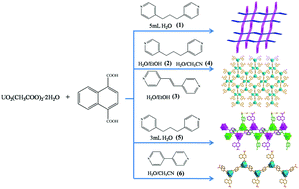当前位置:
X-MOL 学术
›
Dalton Trans.
›
论文详情
Our official English website, www.x-mol.net, welcomes your
feedback! (Note: you will need to create a separate account there.)
Six uranyl-organic frameworks with naphthalene-dicarboxylic acid and bipyridyl-based spacers: syntheses, structures, and properties†
Dalton Transactions ( IF 3.5 ) Pub Date : 2018-02-13 00:00:00 , DOI: 10.1039/c7dt04909a Wei Xu 1, 2, 3, 4, 5 , Ya-Nan Ren 1, 2, 3, 4, 5 , Miao Xie 1, 2, 3, 4, 5 , Lin-Xia Zhou 1, 2, 3, 4, 5 , Yue-Qing Zheng 1, 2, 3, 4, 5
Dalton Transactions ( IF 3.5 ) Pub Date : 2018-02-13 00:00:00 , DOI: 10.1039/c7dt04909a Wei Xu 1, 2, 3, 4, 5 , Ya-Nan Ren 1, 2, 3, 4, 5 , Miao Xie 1, 2, 3, 4, 5 , Lin-Xia Zhou 1, 2, 3, 4, 5 , Yue-Qing Zheng 1, 2, 3, 4, 5
Affiliation

|
A new series of uranium coordination polymers have been hydrothermally synthesized by using 1,4-naphthalene dicarboxylic acid (H2NDC), namely, (H3O)2[(UO2)2(NDC)3]·H2O (1), (H2-bpp)[(UO2)2(NDC)3]·EtOH·5H2O (2), (H2-bpe)2/2[(UO2)2(NDC)3]·EtOH (3), (H2-bpp)[(UO2)2(NDC)3]·5H2O (4), (H2-bpp)[(UO2)(HNDC)(NDC)]2·2H2O (5), and (H2-bpy)[(UO2)(NDC)2] (6) [bpp = 1,3-di(4-pyridyl) propane, bpe = 4,4′-vinylenedipyridine, bpy = 4,4′-bipyridine]. Single-crystal X-ray diffraction demonstrates that complex 1 represents the uranyl-organic polycatenated framework derived from a simple two-dimensional honeycomb grid network structure via a H2NDC linker. Complexes 2–4 contain the dinuclear motifs of the two UO7 pentagonal and one UO8 hexagonal bipyramids which are linked by NDC2− anions creating a (UO2)4(NDC)2 unit, and further extend to a 2D layer through NDC2− anions. Complex 5 displays a 1D zigzag double chain structure, in which the carboxylate groups of the NDC2− anions adopt a chelate mode and further extends to a 2D framework via hydrogen bonds. The 1D structure of complex 6 is similar to the zigzag chain of complex 5. In addition, powder X-ray diffraction, elemental analysis, IR, thermal stability and luminescence properties of all complexes have also been investigated in this paper. The photocatalytic properties of the six complexes for the degradation of tetracycline hydrochloride (TC) under UV irradiation have been examined. Moreover, density functional theory (DFT) calculations were carried out to explore the electronic structural and bonding properties of the uranyl complexes 1–6.
中文翻译:

六个带有萘二甲酸和联吡啶基间隔基的铀酰-有机骨架:合成,结构和性质†
通过使用1,4-萘二甲酸(H 2 NDC)(即(H 3 O)2 [(UO 2)2(NDC)3 ]·H 2 O(1),(H 2 -bpp)[(UO 2)2(NDC)3 ]·EtOH·5H 2 O(2),(H 2 -bpe)2/2 [(UO 2)2(NDC)3 ] ·EtOH(3),(H 2 -bpp)[(UO 2)2(NDC)3 ]·5H 2 O(4),(H 2 -bpp)[(UO 2)(HNDC)(NDC)] 2 ·2H 2 O(5)和(H 2 -bpy)[(UO 2)(NDC)2 ](6)[bpp = 1,3-二(4-吡啶基)丙烷,bpe = 4,4′-亚乙烯基二吡啶,bpy = 4,4′-联吡啶]。X射线单晶衍射表明,配合物1代表通过H 2 NDC接头从简单的二维蜂窝状网格网络结构衍生而来的铀酰-有机多链骨架。配合物2-4含有两个UO 7五边形和一个UO 8六边形双锥体的双核基序,它们通过NDC 2-阴离子连接,形成(UO 2)4(NDC)2单元,并进一步通过NDC 2-阴离子延伸到2D层。配合物5显示一维Z字形双链结构,其中NDC 2-阴离子的羧酸盐基团采用螯合模式,并通过氢键进一步延伸至2D骨架。配合物6的一维结构类似于配合物5的锯齿形链。此外,本文还研究了所有配合物的粉末X射线衍射,元素分析,IR,热稳定性和发光性能。考察了这六种配合物在紫外辐射下降解四环素盐酸盐(TC)的光催化性能。此外,进行了密度泛函理论(DFT)计算,以探索铀酰复合物1–6的电子结构和键合性质。
更新日期:2018-02-13
中文翻译:

六个带有萘二甲酸和联吡啶基间隔基的铀酰-有机骨架:合成,结构和性质†
通过使用1,4-萘二甲酸(H 2 NDC)(即(H 3 O)2 [(UO 2)2(NDC)3 ]·H 2 O(1),(H 2 -bpp)[(UO 2)2(NDC)3 ]·EtOH·5H 2 O(2),(H 2 -bpe)2/2 [(UO 2)2(NDC)3 ] ·EtOH(3),(H 2 -bpp)[(UO 2)2(NDC)3 ]·5H 2 O(4),(H 2 -bpp)[(UO 2)(HNDC)(NDC)] 2 ·2H 2 O(5)和(H 2 -bpy)[(UO 2)(NDC)2 ](6)[bpp = 1,3-二(4-吡啶基)丙烷,bpe = 4,4′-亚乙烯基二吡啶,bpy = 4,4′-联吡啶]。X射线单晶衍射表明,配合物1代表通过H 2 NDC接头从简单的二维蜂窝状网格网络结构衍生而来的铀酰-有机多链骨架。配合物2-4含有两个UO 7五边形和一个UO 8六边形双锥体的双核基序,它们通过NDC 2-阴离子连接,形成(UO 2)4(NDC)2单元,并进一步通过NDC 2-阴离子延伸到2D层。配合物5显示一维Z字形双链结构,其中NDC 2-阴离子的羧酸盐基团采用螯合模式,并通过氢键进一步延伸至2D骨架。配合物6的一维结构类似于配合物5的锯齿形链。此外,本文还研究了所有配合物的粉末X射线衍射,元素分析,IR,热稳定性和发光性能。考察了这六种配合物在紫外辐射下降解四环素盐酸盐(TC)的光催化性能。此外,进行了密度泛函理论(DFT)计算,以探索铀酰复合物1–6的电子结构和键合性质。











































 京公网安备 11010802027423号
京公网安备 11010802027423号